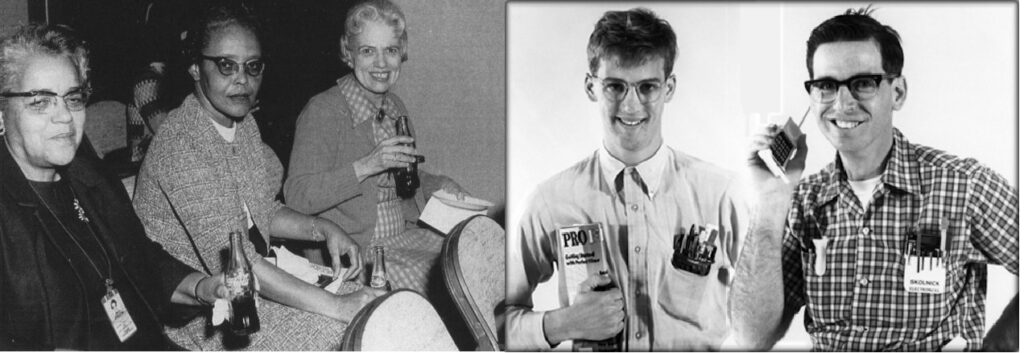
Revenge on the Nerds
Democratising education to diversify the workplace
Part 1: Formal Education
I’m sure I’m not the only one who has spent time learning during the pandemic. Even if you didn’t attempt to fit all of humankind’s knowledge into your brain just because you had a few months of downtime, you’ve probably attended at least a couple of the seemingly never-ending webinars that audio manufacturers and groups have kindly made available to us. I chose to learn how to code and found there are so many parallels with audio, both in the nature of the subject and how it’s taught. It keeps reminding me of the tiresome debates about why our workplace isn’t more diverse: for whatever underrepresented group is being discussed, it gets suggested that they just aren’t interested, they aren’t cut out for it, or the people who do well in the industry are there because they’re naturally suited to the role. The solution, if it’s seen as a problem at all, is to encourage more of that underrepresented group to study STEM (science, technology, engineering and mathematics) subjects at school. Everyone breathes a sigh of relief that it’s the next generation’s problem and they’ve narrowly avoided having to examine or change their own behaviour or the processes they participate in, and they go back to the status quo.

The people on the left are computer programmers, the people on the right are actors. Credit (left): NASA
Unfortunately, “more education” is not the panacea it’s touted to be and actually presents its own set of problems. One coding lecturer explained that he had named his course “Python for Everybody” (which I highly recommend, available for free from http://www.dr-chuck.com/) because he wanted to make computer programming truly accessible for everyone and stop it being the reserve of nerdy gatekeepers who hoarde the knowledge for themselves (I may be paraphrasing slightly). That really resonated with me, because I’ve seen it time and again in audio too.
We’ve been raised by movies and sitcoms to see ‘nerds’ as mostly harmless goofballs, born with huge analytical brains and zero social skills, who deserve to succeed because they got bullied by ‘jocks’ in school. It’s apparently inevitable that most computer programmers, physicists, mathematicians and even audio engineers are straight, white or Asian, middle-class men because the nerd stereotype teaches us they are the ones who are born to fit those roles. This simply isn’t the case and teaching in a way that only appeals to people who think like them is a self-fulfilling prophecy that they’re the only ones who can do that work. If we want to encourage and retain a more diverse workforce in every sense, we need to change how we participate in education, both as teachers and pupils.
Case study: Women computer programmers
[I apologise for the length of this example, but I found it so fascinating and it had so many echoes of audio that I had to share. There’s a tl, dr: at the end.]

Women programming the first digital computer, “ENIAC”, for the US military c. 1946. They were given no credit for their work at the time and it was later presumed they were simply models. Credit: U.S. Army photo from Getty Images.
Women have been involved in computer programming from the very beginning. Ada Lovelace, while probably not the first programmer as is often claimed (1), had a thorough and profound understanding of the potential of computing machines, even beyond their inventor Charles Babbage’s. When the first “digital computer” was built for the U.S. military during the second world war, six women were the ones who programmed it, because they were already working as ‘computers’: humans who did calculations (2). As far back as 1943, women of colour were performing calculations for NACA (which became NASA), as immortalised in the film Hidden Figures (3). They proved to any doubters that women and people of colour were perfectly capable of handling mathematical and engineering problems, efficiently and under pressure.
For the first few decades of modern computing, hardware production was seen as important, ‘manly’ work and software programming, like manual computing, was seen as menial administrative work, so was commonly done by women. There are countless instances from the time of people using traditional gender stereotypes to explain why women were naturally suited to coding, because they were meticulous and good at repetitive tasks like knitting or typing. Even Dr. Grace Hopper, a behemoth in the world of coding, said in a Cosmopolitan article from 1967 that it was “just like planning a dinner… …Programming requires patience and the ability to handle detail. Women are ‘naturals’ at computer programming.” (4).

The first women programmers didn’t have manuals to learn from, and had to figure out what to do from first principles, using paper diagrams at first because they didn’t have security clearance to enter the room that housed the computer. I defy anyone in audio to look at these banks of circuits and not see patch boards. Credit: U.S. Army photo from the ARL Technical Library.
The boom in computing was so great that there were far more jobs than candidates, even after men came back from the war. This opened up opportunities to people who might otherwise have been excluded. The New York Times Magazine cites a time when a young woman of colour called Arlene Gwendolyn Lee applied for a systems analytics job in Toronto in the 1960s. “Lee persuaded the employers, who were all white, to let her take the coding aptitude test. When she placed in the 99th percentile, the supervisors grilled her with questions before hiring her. “I had it easy,” she later told her son. “The computer didn’t care that I was a woman or that I was black. Most women had it much harder.” (5).
Unfortunately, those tests that allowed everyone’s aptitude to shine through regardless of appearance or background gradually came to be accompanied by personality tests, which selected for ‘detached’ people who were less likely to have home or social commitments and could therefore dedicate longer hours to the job. “The primary selection mechanism used by the industry selected for antisocial, mathematically inclined males, and therefore antisocial, mathematically inclined males were overrepresented in the programmer population; this, in turn, reinforced the popular perception that programmers ought to be antisocial and mathematically inclined (and therefore male), and so on ad infinitum.”(6). This, combined with the marketing of personal computers in the 1980s as boys’ toys, slowly eroded women’s position in the field. It paved the way for middle-class white boys, whose families could afford personal computers and would usually keep them in the son’s room, to arrive at college having had years of experience experimenting and learning to code in their spare time. Anyone else who joined computer science courses was made to feel inferior or not suited to the subject because they lacked that exposure. However, when the gender disparity in university courses was examined, “It turned out that having prior experience is not a great predictor, even of academic success”, “the pace of learning at college was so much more intense that by the end of the degree, everyone eventually wound up graduating at roughly the same levels of programming mastery.” (5).
So women, including women of colour, had been showing up and doing the work from the outset, and the research found they were just as capable as men, and yet even now biology and gender stereotypes are used to support men’s dominance in the field. A Google engineer’s 2017 memo against their affirmative action policies (7) caused quite a lot of hyperbole on each side of the argument, but it exemplified this attitude to women in tech. Despite the engineer’s bachelor’s and master’s degrees in biology from Ivy League universities, his arguments made clear that he didn’t understand the field’s nuances or consensus on humans’ innate abilities (8) or, in fact, what it takes to be an engineer (9). Judging by the ensuing internet meltdown, and conversations I see again and again in our own field, he’s far from alone in holding those views.
Tl, dr: People have been using gender stereotypes to explain women’s involvement in computer programming from the beginning. First to justify their aptitude for it, then to justify their absence from it. Starting a course with prior experience of the topic might make a student seem more promising than others, but by the end, even students with no prior experience will have caught up.
What’s holding us back?
The case of women in computer programming covers some major points of what limits women and minorities’ participation in STEM, especially PECS (physics, engineering and computer science). A very useful Physics Today article (10) outlines worries students may have that can lead to them dropping out or underperforming, and how they can be addressed effectively. There are concerns about belonging, about being able to improve, and being respected by classmates and teachers alike. These often stem from harmful stereotypes about nerds, and opinions about innate ability. I have previously discussed how ‘fetishising brilliance’: i.e., believing that natural talent is the main requirement for success in a given field, enables discrimination and reduces diversity (11). It is particularly damaging in an education setting because it can discourage students from even trying, and educators are less likely to put the effort in to teach pupils who don’t take to a subject immediately (10).
What can we do?
The good news is there are ways to counteract these effects. For example, it is true that, on average, women perform less well on spatial reasoning tests than men. Whatever the reasons for this, potentially because boys more than girls are raised to play with toys that improve that skill, the gap in ability can be narrowed significantly with one 15 hour course (12) or even just 10 hours of playing spatially rich video games (13). This is a huge deal because many PECS courses start with activities that emphasise spatial reasoning, alienating people who are less skilled in it from the start, even though they may be perfectly competent in other areas of the subject. This can have a ripple effect on their feelings of fitting in and competence, and they are more likely to drop out of the class altogether.
Fostering a ‘growth’ mindset (“I can improve”), rather than a ‘fixed’ mindset (“I was born with a certain set of abilities”), is massively beneficial too: ‘Students with a fixed mindset who encounter a difficult problem or concept see that difficulty as evidence that they lack ability. Across many different research studies, such students tend to seek out easy problems (to prove their ability) and avoid challenging ones that would help them learn. They avoid speaking up in class or in group discussions so they don’t seem stupid. When they face setbacks, they lose motivation and turn their attention to subjects for which they feel more “natural” ability.
In contrast, students who have a growth mindset see difficulties as opportunities to learn—“I love a good challenge!” So they work harder and ask more questions, which naturally improves their learning.’ (10). A key way educators can encourage this way of thinking is to explicitly state in their feedback that they are giving it precisely because they believe the student is capable of improving, rather than trying to comfort them for their lack of ability (10).
Don’t make it awkward
Perhaps counterintuitively, these measures work best to improve diversity when they’re offered to everyone (10). Singling underrepresented groups out for special treatment can make them feel less able and like they don’t belong. It can also cause friction with other classmates who think they’re being offered an unfair advantage. Interventions like playing video games can help all students, but they tend to have the biggest effect on the people who have the biggest improvements to make, thus levelling the playing field without explicitly helping one group over another (10, 13).
It may seem strange for an advocate of Soundgirls, which is aimed mainly at an underrepresented group in audio, to recommend against targeted initiatives. Of course, I feel that organisations and fora specifically for underrepresented groups can be very beneficial. They can counteract the feeling of not belonging, and provide an understanding and supportive environment that they may not have access to elsewhere. However, it’s essential that people seek these organisations out and partake in them because they choose to, not because their school or teacher tells them they need to.
Key takeaways
Next time I’ll discuss more detailed examples of how we can help to attract a wider variety of people to our industry through teaching. Until then, the key points to remember, whether you’re learning or teaching, are:
Not knowing something doesn’t make you stupid: We all come from different backgrounds and have different life experiences. The whole point of learning is to fill gaps in your knowledge. Mocking a student for not knowing something is about as impressive and helpful as yelling from the sidelines of a Peewee game that they suck.
We’re all different, but we have the same potential to learn: Don’t rely on lazy stereotypes and cherry-picked biological research to justify prejudices.
A growth mindset is a key to learning: Viewing learning demanding topics as a fun challenge rather than evidence of unsuitability to a field results in the best and longest-lasting improvements.
Movies and sitcoms lied to you: Wearing glasses and a pocket protector doesn’t make you smart. Who knew?
References:
- https://www.bbvaopenmind.com/en/technology/visionaries/ada-lovelace-original-and-visionary-but-no-programmer/
- https://www.history.com/news/coding-used-to-be-a-womans-job-so-it-was-paid-less-and-undervalued
- https://en.wikipedia.org/wiki/West_Area_Computers
- http://thecomputerboys.com/wp-content/uploads/2011/06/cosmopolitan-april-1967-1-large.jpg
- https://www.nytimes.com/2019/02/13/magazine/women-coding-computer-programming.html
- The Computer Boys Take Over by Nathan Ensmerger https://books.google.co.uk/books?id=VCcsTPQ738oC&q=infinitum&redir_esc=y#v=onepage&q=antisocial&f=false
- https://en.wikipedia.org/wiki/Google%27s_Ideological_Echo_Chamber
- https://www.wired.com/story/the-pernicious-science-of-james-damores-google-memo/
- https://medium.com/@yonatanzunger/so-about-this-googlers-manifesto-1e3773ed1788
- https://physicstoday.scitation.org/doi/10.1063/PT.3.2383
- https://soundgirls.org/how-to-find-the-best-candidate-for-the-job/
- https://www.kqed.org/mindshift/43802/can-teaching-spatial-skills-help-bridge-the-stem-gender-gap
- https://journals.sagepub.com/doi/full/10.1111/j.1467-9280.2007.01990.x